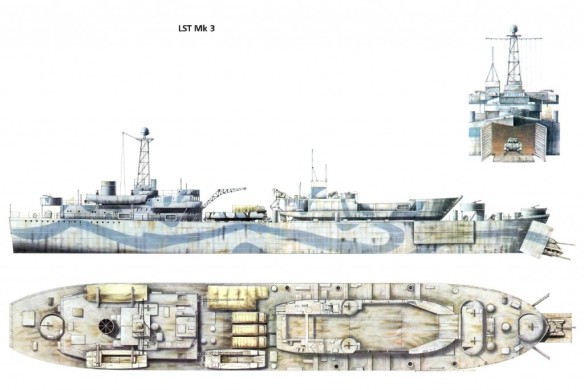USS LST-742 on 13 October 1950 at Wolmi-do Island, Inchon Harbor, loading supplies for the upcoming Wonsan invasion.
So well did the LST(2) suit the needs of the Americans that the UK had difficulty in being allocated suitable numbers from the construction programme that it had itself initiated. Eighty were needed, and it was decided to improvise on the LST(2) design, with 45 to be built in the UK and the remainder in Canada. There were two major problems.
Firstly, the locomotive diesels used by the Americans were fully committed and, as no alternative existed to the British, they had to specify the simple steam reciprocating engines used in the frigate programme. As amphibious warfare ships were now commanding a priority as high (or even higher) than frigates, this caused little headache, but the machinery and its boilers were bulky and heavy, both intruding into the tank deck space and causing the ship to ground by the stern rather than the bows on beaches of minimum declivity.
The second problem lay in construction techniques for as British and Canadian yards had, as yet, no experience in large-scale welding, riveting was necessary. Even though a hard chine was adopted to simplify construction, the Landing Ship, Tank Mk 3 or LST(3) took longer to build, and the resulting low-efficiency hull was disappointingly slow. Though significantly longer to accommodate the steam machinery and disposing of over three times the power, the LCT(3) was only 3 kts faster than the diesel-driven American LST(2)s. No camber was included on the weather deck; this was a counter-productive shortcut as loose water was very loathe to disperse.
With their deeper draught, the LST(3)s tended to ground farther from the dry beach and a double-section bow ramp was incorporated as part compensation, although floating causeway sections were again a successful answer. The LST(3)s were very well built, having LCAs under their gravity davits and the capacity to stow up to seven LCM(7)s on the upper deck, These were offloaded via a 30- ton SWL derrick set on a portside kingpost forward of the bridge. A 15-ton derrick was stepped on the other post. Though a few of the programme were eventually cancelled, the 44 British and 28 Canadian ships completed gave 20 years and more of post-war service.
General characteristics
Displacement: 2,140 tons light 4,980 long tons (5,060 t) full load Length: 347 ft (106 m) o/a Beam: 55 ft 2 in (16.81 m) Draught: Loaded : 4 ft 7 in (1.40 m) bow 11 ft 6 in (3.51 m) stern Ramps: 23 feet by 14 feet ramp Propulsion: Twin screws, steam reciprocating engines, 5,500 hp (4,100 kW), 10 ft (3.0 m) propeller Speed: 13 knots (24 km/h; 15 mph) Capacity: 10 tanks plus 15 vehicles Troops: 13 officers and 150 men Complement: 14 officers and 90 men Armament: 8 × 20 mm Oerlikon for A/A defence on some ships
